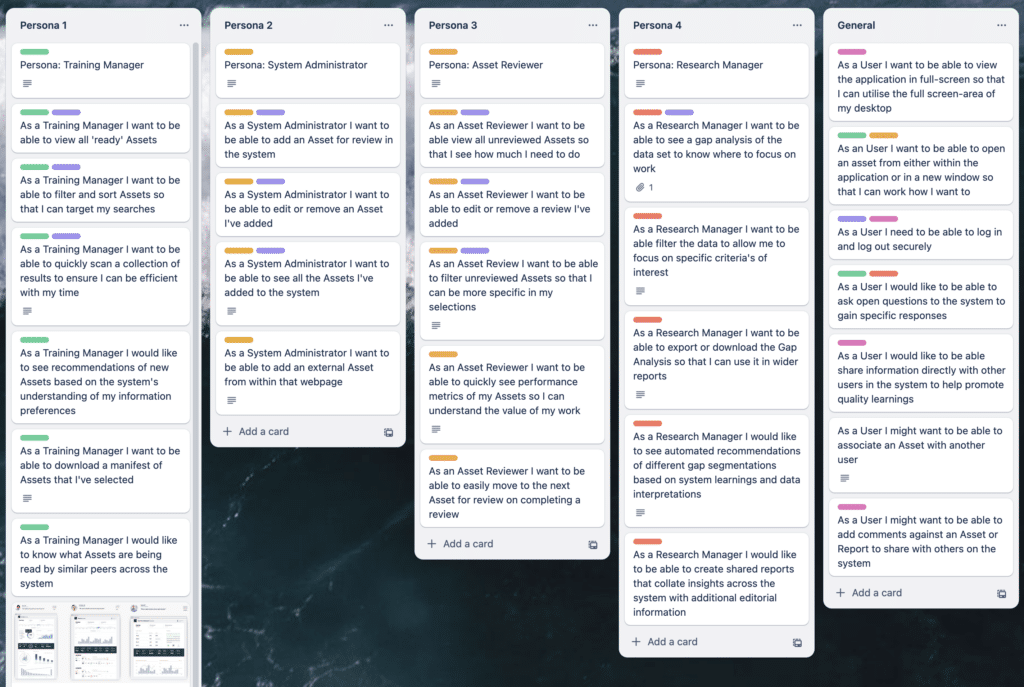

Devstars
Whilst often associated with larger project development, at Devstars, we often encourage clients to consider an MVP approach. Whether we are building a complex web application for Heathrow Airport or a single-page site for an SMB, this article should provide everything you need to get started.

A Minimum Viable Product (MVP) is the most simplified version that includes only its core features and functionalities. It is developed to test the concept’s viability in the market with minimal resources and effort. An MVP allows entrepreneurs to collect valuable user feedback, validate assumptions, and make data-driven decisions before investing significant time and resources into full-scale product development.
For example: For an SMB like Aerobic Technologies, we recommended a single-page site and then added a case studies template. Over time we may add product and blog pages as the business grows.
The primary purpose of an MVP is to gather insights and learn from real users in the market as early as possible. By releasing an MVP, startups can test their hypotheses, understand user preferences, and identify potential areas of improvement. The feedback from early users can guide the product’s future development, ensuring it aligns with market needs and demands.
Building an MVP offers numerous advantages for startups and entrepreneurs:
An effective MVP should consist of the following key elements:
In the next section, we will explore how to identify your target market and problem statement to ensure your MVP resonates with your audience.
Before diving into the development of your MVP, it’s crucial to have a clear understanding of your target audience. Conduct thorough market research to identify your potential customers’ demographics, preferences, and pain points. Knowing your audience can tailor your MVP to their specific needs, increasing the chances of successful adoption.

Example: User Persona: Motocross Accessories
A successful MVP addresses a specific problem faced by your target market. Identify the pain points your potential customers are experiencing and determine how your product can offer a solution. This deep understanding of customer pain points will guide the development of features that truly resonate with your audience.
Once you’ve identified the pain points, craft a clear problem statement that concisely describes the issue your MVP aims to solve. This problem statement will guide the development process, ensuring the product remains focused on its core purpose.
Thorough market research is the foundation of a successful MVP. Analyse your industry, competitors, and target audience to gain insights into existing solutions and potential gaps. Understand the market trends and customer behaviour to position your MVP effectively.
Not all businesses will have the funds to bring in third-party market research, but testing your product with family, friends, and colleagues can give you a new perspective and valuable input.
Study your competitors’ products and strategies to identify areas where you can differentiate your MVP. Look for weaknesses in their offerings and find ways to address those pain points better. By providing a unique value proposition, you can attract customers away from competitors.
Tools like Similarweb can expand on and validate your client’s own thoughts.
Engage with your potential customers early on and gather their feedback on your MVP idea. Conduct surveys, interviews, or focus groups to understand their preferences and expectations. This valuable feedback will help you refine your MVP before its official launch.
Hotjar will provide heatmaps and allow you to record and follow visitors’ mouse movements and clicks. Additionally, you can setup questionnaires and polls to get direct feedback on your app or website.
As you envision your MVP, distinguish between essential features (must-haves) and additional functionalities (nice-to-haves). Focus on the must-have features that directly address the problem statement and provide value to your users.

If you are all in the same room, post-it notes are great, but for remote working, a Kanban board like Trello can be handy to explore and prioritise features.
The development of an MVP is typically constrained by time and resources. Prioritise the features based on their importance and feasibility for the initial release. This ensures that the core functionalities are developed first and allows for faster product validation.
Emphasise user-centric design principles during the MVP’s development. The user interface should be intuitive, visually appealing, and optimised for easy navigation. Keep the user experience at the forefront of all design decisions. Remember, this is an MVP, so keep things simple.
Before delving into full-fledged development, create wireframes and prototypes to visualise the MVP’s layout and functionality. Prototyping allows you to gather early feedback from stakeholders and users and make necessary adjustments.
Selecting the appropriate technology stack is vital for the success of your MVP. Consider scalability, compatibility, and development speed when choosing programming languages, frameworks, and tools.
Adopt an Agile development approach to build your MVP in iterative stages. The Agile methodology allows for flexibility and quick adaptation to changes, which is crucial when developing an MVP that may evolve based on user feedback.
Testing your MVP rigorously is essential to ensure it functions smoothly and meets user expectations. Perform thorough quality assurance testing to identify and fix any bugs or usability issues.
Engage real users in usability testing to gather feedback on the MVP’s functionality and user experience. Usability testing provides valuable insights into how users interact with the product and uncovers areas for improvement.
Before the official launch, consider conducting a soft launch of your MVP to a limited audience or a specific geographic region. This approach allows you to gather early feedback, identify any last-minute issues, and make improvements before the full-scale launch.
Develop a comprehensive user onboarding process to guide new users through the MVP’s features and functionalities. An intuitive onboarding experience increases user retention and ensures that users can quickly grasp the value of your product.
Establish clear KPIs to measure the success of your MVP. Typical metrics include user engagement, customer acquisition cost, retention, and conversion rates. Regularly track and analyse these metrics to assess the product’s performance.
User engagement is a crucial indicator of your MVP’s success. Monitor metrics like user activity, time spent on the platform, and the frequency of visits. High user engagement suggests that your MVP effectively meets user needs and generates interest.
Continuously encourage users to provide feedback on their experiences with the MVP. Implement feedback forms, in-app surveys, or direct communication channels. This user input will guide ongoing improvements and updates.
Based on user feedback and performance metrics, iterate and enhance your MVP continuously. Implement updates and new features that align with user needs and preferences. A continuous improvement process ensures that your product stays relevant and competitive.
Be prepared for scalability as your MVP gains traction and attracts more users. Ensure your infrastructure, technology, and team can handle increased demand and user growth. Scalability is essential for sustaining momentum and achieving long-term success.
Anticipate the challenges that may arise as your MVP scales—plan for increased customer support, server capacity, and potential expansion into new markets. Proactive preparation helps maintain a smooth user experience during periods of rapid growth.
One common pitfall is overengineering the MVP by including unnecessary features or functionalities. This can lead to delays in launching the product and higher development costs. Stay focused on the core value proposition and avoid feature creep.
Neglecting user feedback can hinder the success of your MVP. Engaging with users and incorporating their suggestions is essential for enhancing the product and meeting customer expectations.
Without clear goals and metrics for success, evaluating the MVP’s performance accurately becomes challenging. Set specific and measurable goals from the outset to track progress effectively.
Airbnb: Airbnb’s MVP was a simple website listing a spare room for rent during a conference. This allowed them to validate the demand for a peer-to-peer lodging marketplace.
Dropbox: Dropbox started as a simple video demonstrating the core concept. This MVP allowed them to gauge user interest and gather a waitlist of potential customers before building the full product.
Uber: Uber’s MVP was a simple app connecting iPhone users with San Francisco drivers. This allowed them to validate the demand and logistics of a ride-hailing service before expanding.
In conclusion, a Minimum Viable Product (MVP) is a powerful tool for startups and entrepreneurs to validate their ideas, gather user feedback, and build successful products. By following the outlined steps, including identifying your target market, defining a clear problem statement, and engaging in continuous improvement, you can maximise the potential of your MVP. Embrace iteration and innovation, always keeping the user at the centre of your product development journey.
An MVP is the most simplified version of a product, including only core features, developed to test its viability in the market.
MVPs allow startups to validate their ideas, gather feedback, and reduce the risk of investing in a full-scale product without proven demand.
Prioritize features based on their importance in solving the target audience’s pain points and feasibility for early development.
Overengineering the MVP, ignoring user feedback, and failing to define clear goals are common pitfalls to avoid.
Define key performance indicators (KPIs) for user engagement, customer acquisition, retention, and conversion rates. Regularly track and analyse these metrics to assess success.
Send us a brief message outlining
your project and we’ll get back to
you asap to discuss your project
in more detail.